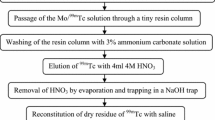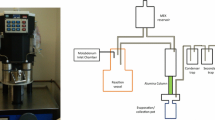Abstract
The molybdenum targets of 2–10 mg/cm2 have been prepared on Al and Ti backings by centrifugal sedimentation. The thickness and purity of the produced targets were analysed with Rutherford back scattering measurements, scanning electron microscope and energy dispersive spectrometry. Targets were requested for pilot studies of an alternative accelerator way of 99mTc production. Targets were tested with deuteron beam of 20 MeV energy and 10 nA intensity. They were irradiated for 10 min and showed no damage what proofed the targets suitability for irradiation with a weak beam of light projectiles.
Similar content being viewed by others
Avoid common mistakes on your manuscript.
Introduction
The target manufacturing laboratory was requested to produce natural molybdenum targets of 2–10 mg/cm2 on a backing to complete research and development of manufacturing the technetium-99m in reaction of molybdenum with a deuteron beam.
This request is a part of a new program investigating alternative methods of technetium-99m production, an important radioisotope in medical diagnostic. The technetium-99m is used in medicine for diagnosis as a radioactive tracer that medical equipment can detect in the human body. Technetium-99m has a short life-time, too short to store it in hospitals and thus it must be prepared shortly before admission to patient using a technetium-99m generator. It is produced through the beta decay of molybdenum-99 from which has to be extracted.
The molybdenum-99, source of technetium-99m, all over the world was rutinally produced in reactors which mostly were built in the 1960s and many of them approach an service end. This, in consequence means a drop of the technetium-99m generators in near future.
Since the technetium-99m is produced by decay of the short lived molybdenum-99, the idea is to investigate the production probability of this isotope by nuclear reaction. The question of technetium-99m production in an alternative way, for local or regional users, raised since problem with further production of molybdenum-99 in reactors appeared. A natural molybdenum will be at first used to study the feasibility of the target fabrication, to measure production yield of molybdenum-99 in (d,p) reactions, and to qualify and quantify produced impurities. The result will be then compared to the results obtained for the 98Mo(d,p)99Mo reaction.
The objective of work presented in this paper was to provide the molybdenum targets to physicists who are developing a local facility aimed to produce technetium-99m through the above mentioned reaction as complementary to the reactor method.
Target production
The final goal is to produce 98-molybdenum targets. The requested targets have to be prepared on a backing. Because they have to be relatively thick the vacuum evaporation techniques was not considered as it would lead to excessive lose of the expensive isotopic material. That is why we decided to produce the targets by centrifugation technique [1, 2]. The method is well known as suitable for targets preparation with wide range of thickness and we decided to test the method producing targets with required parameters using natural molybdenum.
The best results with the sedimentation by centrifugation technique are achieved when deposit is produced with very fine powder (with grains diameter below 100 nm) but unfortunately the finest powder of molybdenum available in the market has grains of 2 μm in diameter. Thus we produced targets with available grains.
Equipment
In order to manufacture the targets with the centrifugation method we used the equipment inherited from the “target manufacturing lab” of the former Institute for Nuclear Physics at Grenoble after its closing down. The sedimentation tube used in target production is composed of an aluminium centrifuge tube, a Teflon washer, and disc covered with neoprene (Fig. 1). The parts of tube have to be assembled tightly to avoid the leaks at its bottom. The target backing was placed between the neoprene disc and the Teflon washer.
Backing
The backing is not specific to the method. For this test production the physicist has chosen aluminium and titanium. We used aluminium backing of 100, 200, 500 and 600 μm, and titanium backing of 400 μm with a diameter of 16 mm.
The backing surface needs to be rough sufficiently to assure a satisfying adhesion of the molybdenum layer [1, 2]. For this experiment we used commercial foils and applying the surface abrasion with sand paper we have obtained a roughness sufficient to produce a mechanically stable well adhering target.
Methodology
The powder of molybdenum was mixed with collodion solution to produce a film around each grain. The amount of powder weighed accordingly to the requested thickness of the target with 10 % excess to compensate the losses during handling of the powder was placed in a bottle with 2 ml of 1.2 % collodion solution in amyl acetate. The solution viscosity was set accordingly to the density of the metallic powder [1, 2].
The bottle was placed in an ultrasonic bath for 30 min to produce the good quality slurry. Then the solution was transferred to the centrifuge tube mounted with the backing cleaned with acetone before the tube assembling. The tube with slurry was placed in the centrifuge where was spun at 3,500 rpm during 60 min.
After completing the sedimentation we removed the excess of the solvent with a micropipette and left the target for polymerizing during minimum 12 h.
Results
Following above described protocol we produced targets of 2, 5 and 10 mg/cm2, in respect to molybdenum, with a diameter of 12 mm on aluminium backing.
At first approach the thickness of the produced targets was estimated knowing:
-
the mass of molybdenum deposited on a backing (molybdenum mass was measured by weighing on a balance with an accuracy of 0.1 mg)
-
the target diameter.
Targets of each thickness were analysed by Rutherford Back Scattering (RBS) and energy dispersive spectrometry (EDS) and their surface was observed by scanning electron microscope (SEM). Analyses where performed at CSNSM (Centre de Spectrométrie Nucléaire et de Spectrométrie de Masse) after the experiment.
With help of RBS we estimated densities of the produced targets.
The RBS yield is expressed as
where A is the number of detected particles, Q the number of incident particles, Ω the detection solid angle, σ the Rutherford cross section, ρ the target density and t its thickness. As all the studied samples are large considering the range of the used projectiles (4 He at 1.4 MeV) in Mo, one can assume that crossed thickness t is the same for all the studied targets.
Moreover, all the measured yields are normalized to the beam intensity and as all measurements were done with the same beam and geometry: Q, Ω, and σ are the same for all measured samples. As we used as well the reference sample of known density we may deduce densities of studied targets from
On the RBS spectrum (Fig. 2) we can see the reference spectrum of solid molybdenum that corresponds to a known density of 10.28 mg/cm3. The amplitude of the spectra with respect to the reference material give us the density of studied targets.
The densities of all 3 studied targets are lower than the reference one and are equal to 46 % (of the density of reference material), 71 and 73 % for 2, 5 and 10 mg/cm2 target, respectively.
We observe almost a saturation of the density for 5 and 10 mg/cm2 target, this is probably due to the size of the particles of the used powder. If we had used a finer powder the value of densities would probably be closer to the density of solid molybdenum.
Using the actual densities of the studied targets we have recalculated their linear thickness and we obtained: \( 2\;{\text{mg}}/{\text{cm}}^{ 2} = 4. 2 3\;\upmu {\text{m}}, 5\;{\text{mg}}/{\text{cm}}^{ 2} = 6. 9\;\upmu {\text{m}}, 10\;{\text{mg}}/{\text{cm}}^{ 2} = 1 3\;\upmu {\text{m}} \).
The elemental composition of 2, 5 and 10 mg/cm2 targets was analysed with an EDS technique. Spectrum obtained for thinner target (Fig. 3) shows presence of four elements: molybdenum, aluminum, oxygen and calcium.
Presence and height of the pick corresponding to aluminum shows that target is composed of islands made of molybdenum grains and voids through which aluminum backing is accessible for X-rays used for analyses and so will be for projectiles planned to be used for Tc production.
We suppose that oxygen originates from collodion which serves as a binding material. Appearance of calcium can be explained by targets contamination, may be originating from talc gloves used by physicists during the manipulation of the target in the experimental area.
The target of the 2 mg/cm² was analyzed by SEM (Fig. 4). We observed that the surface is not homogeneous, so we suppose that the size of molybdenum grains is too large for producing homogenous layer of this thickness.
In the SEM image a mapping of the different element constituting the target was made with EDS analysis (Fig. 5) allowing identification of calcium oxide.
Results of EDS analysis of thicker target, i.e. 5 mg/cm2 (Fig. 6) show that in this target there are still small traces of aluminum as well as the presence of calcium oxide, probably introduced at the same way as described above.
Spectrum obtained for the thickest target, 10 mg/cm2 (Fig. 7) does not show a pick corresponding to aluminum. As well there is no pick corresponding to calcium what confirms that the contamination of the target was caused by the manipulation of the target in the experimental area, for which the talc gloves were used. This conclusion is based on fact that thickest targets were not used in test irradiation.
Conclusions
We can conclude that the centrifugal method can be applied for molybdenum targets production if thicker than 5 mg/cm2. The collodion used as a binder withstand the short irradiation by deuteron beam with low intensity (of 10 nA at 20 MeV and 10 min).
Tests of targets with beam of higher intensity were not yet made but they are foreseen.
The applied technique allows a quick and easy targets production while consuming less material than at other technique.
Advantages
The targets production by centrifugation allows to obtain greater thicknesses in shorter time than vacuum evaporation and with negligible loss of material. It allows preparation of targets with a yield of 90 %.
If vacuum evaporation technique is applied to make this molybdenum target, the losses of material would not be acceptable for expensive isotopic material. In addition technique is easy to apply.
Inconvenience
The collodion composing the target introduces carbon, oxygen and hydrogen into the target what can be a problem for studied reaction.
In a future we plan to produce the self-supporting targets with higher thickness. At this production test we prepared targets with maximum thickness of 25 μ but they were not ridged enough to become self-supporting.
References
Sugai I et al (1977) Nucl Instrum Methods 145:409
Richaud JP (1979) Preparation of targets by a centrifugal method. Nucl Instrum Methods 167:97
Centre de Spectrométrie Nucléaire et de Spectrométrie de Masse, http://www.csnsm.in2p3.fr
Acknowledgement
The authors want to thank Anna Stolarz for very careful reading of the manuscript.
Author information
Authors and Affiliations
Corresponding author
Rights and permissions
About this article
Cite this article
Durnez, A., Petitbon-Thévenet, V. & Fortuna, F. Preparation of molybdenum target by centrifugal method. J Radioanal Nucl Chem 299, 1149–1154 (2014). https://doi.org/10.1007/s10967-013-2655-z
Received:
Published:
Issue Date:
DOI: https://doi.org/10.1007/s10967-013-2655-z











